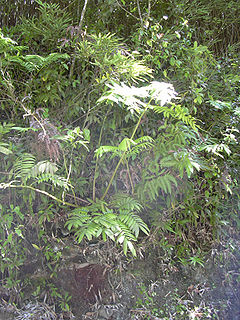- Marattiaceae
-
Marattiopsida 
Mule's-foot fern (Angiopteris evecta) Scientific classification Kingdom: Plantae Division: Pteridophyta Class: Marattiopsida
DoweldOrder: Marattiales
LinkFamily: Marattiaceae
Kaulf.Genera - Angiopteris
- Christensenia
- Danaea
- Eupodium
- Marattia
- Ptisana
Class Marattiopsida is a group of ferns containing a single order, Marattiales, and family, Marattiaceae.[1] Class Marattiopsida diverged from other ferns very early in their evolutionary history and are quite different from many plants familiar to people in temperate zones. Many of them have massive, fleshy rootstocks and the largest known fronds of any fern. The Marattiaceae is one of two groups of ferns traditionally known as eusporangiate fern,[2] meaning that the sporangium is formed from a group of cells vs the leptosporangium in which there is a single initial cell. There have long been four traditional extant genera (Angiopteris, Christensenia, Danaea and Marattia), but recent genetic/cladistic analysis [3] has determined the genus Marattia to be paraphyletic, and the genus has been split into three genera, the two new ones being Eupodium and Ptisana. This fern group has a long fossil history with many extinct taxa (Psaronius, Asterotheca, Scolecopteris, Eoangiopteris, Qasimia, Marantoidea, Danaeites, Marattiopsis, etc.)
In this group, such fronds are found in the genus Angiopteris, native to Australasia, Madagascar and Oceania. These fronds may be up to 9 meters long in the species Angiopteris teysmanniana of Java. In Jamaica the species Angiopteris evecta is widely naturalized and is registered as an invasive species. The plant was introduced by Captain Bligh from Tahiti as a staple food for slaves and cultivated in the Castleton Gardens in 1860. From there it was able to distribute itself throughout the eastern half of the island.
Another East-Asian genus is Christensenia, a peculiar fern with fronds resembling a horse chestnut leaf. That is why the species is called Christensenia aesculifolia, meaning Christensen's chestnut-leaf. Carl Christensen was a famous Danish fern botanist.
The most widespread genus in Marattiaceae is the pantropical Marattia, usually occurring at higher elevations. These are also large ferns with globular rhizomes, but fronds can be up to 4 times pinnate. The sporangia are fused into bivalvate structures called a synangium.
The fourth genus Danaea is endemic to the Neotropics. They have bipinnate leaves with opposite pinnae, which are dimorphic, the fertile leaves much contracted, and covered below with sunken synangia.
The genus Eupodium is also neotropical, with two species. It has fronds that are 2-5 times pinnate, stalked synangia, and awns on the adaxial side of distal blade segments. Blade division decreases towards the apex of the frond. Plants of Eupodium usually only have one frond per plant per year (sometimes two).
Ptisana is a paleotropical genus. These plants are 2-4 times pinnate. Terminal segments usually have a prominent suture where they attach. The sporangia lack the labiate apertures of Marattia and Eupodium, and synangia are deeply cut. The King Fern, Ptisana salicina, from New Zealand and the South Pacific and known in Māori as para now has been placed in this genus. Sometimes called the Potato Fern, this is a large fern with an edible fleshy rhizome that is used as a food source by some indigenous peoples.
Several other genera have been named in the Marattiaceae, namely: Archangiopteris, Macroglossum, Protangiopteris, and Protomarattia. These are all synonyms of Angiopteris.According to recent molecular studies it appears that these eusporangiate ferns may be a sister group to the horsetails (Equisetaceae). Both groups are certainly of ancient lineage.
References
- ^ Smith, Alan R.; Kathleen M. Pryer, Eric Schuettpelz, Petra Korall, Harald Schneider, & Paul G. Wolf (2006). "A classification for extant ferns" (PDF). Taxon 55 (3): 705–731. doi:10.2307/25065646. JSTOR 25065646. http://www.pryerlab.net/publication/fichier749.pdf.
- ^ C.Michael Hogan. 2010. Fern. Encyclopedia of Earth. National council for Science and the Environment. Washington, DC
- ^ Murdock, Andrew G. (2008). "A taxonomic revision of the eusporangiate fern family Marattiaceae, with description of a new genus Ptisana". Taxon 57 (3): 737–755.
External links
Categories:- Marattiopsida
- Pteridophyta families
Wikimedia Foundation. 2010.
